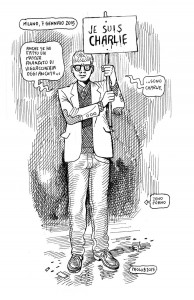NEWS Pencils for Freedom
The first reaction, perhaps the most natural for those who really knew the French magazine Charlie Hebdo and its authors was of absolute disbelief: “A fake, this is the first thing I thought of when I got the news of attack. It was not possible, it had to be yet another provocation, I could not believe it.” These were the words of Giorgio Albertini, illustrator and long time collaborator of Pagine Ebraiche.
The Israeli cartoonist Michel Kichka, who in those very minutes was working with the journalists of the newspaper of Italian Jewry was able to say only “It is a deep shock”, to later remember the times when he had the possibility to work and deal with those who have been murdered. “I knew them, of course, we met at meetings, conferences, presentations… the one I was probably more close to was Tignous, a talented artist with an extraordinary sense of humour, that he turned against himself too. He devoted himself to a form of investigative journalism where his great skill and his passion have been perfect tools to expose many social issues still unresolved, including the problems of immigration, the expulsion of foreigners and especially the lives of those who are in a situation of extreme poverty.”
In the newsroom of Charlie Hebdo there was a group of pioneers who, as mentioned by Giorgio Albertini, had met in the Sixties, working for Hara-Kiri, another satirical weekly later closed by the authorities because it was considered excessive. Its authors had moved en masse to Charlie Hebdo, and formed its core. “There’s a lot of text in their cartoons – explained Kichka – and sometimes you had to learn their language in order to really grasp what they were telling. They focused on French politics, of course, but they had no restrictions or taboos, and have directed their satire on everything, from world politics to religion. Every time something happened in the world of them were remarkable. They have been very critical on Israeli politics too, exactly as the designers Israelis.”
Paolo Bacilieri, author of the heading of DafDaf, the Jewish magazine for kids distributed with Pagine Ebraiche, has responded by drawing a cartoon in which one of his best known characters, Zeno Porno, holds the sign “Je suis Charlie” and says “Although I did a master in advanced cowardice, today I am Charlie too.”
Albertini was drawing when he got the news, and went on listening to updates “I went on like this for hours, and perhaps that is the reason why my first drawings are so full of writing and words. I was drawing for Pagine Ebraiche and I had to restrain myself. They went to execute them, they searched for them knowing what they were doing: the newsrooms of newspapers like Charlie Hebdo are rarely busy, journalists normally gather only on fixed appointments, so they must have kept an eye on them for weeks. It’s horrible to think that they could have waited for the appointment of Angouleme, the comic festival where Charlie Hebdo has a big booth, always packed with people, with all its authors always present. It would have been a massacre, with hundreds of deaths.”
Many cartoonists have immediately honoured the victims and the newspaper, with drawings that praise freedom of expression, and that support the survival of the newspaper. “I really hope that there will be a real understanding of how this act was aimed to affect freedom of expression – comments Albertini – It was a satirical newspaper, they were cartoonists… this is even worse, if it is possible, than if they had attacked another newspaper.”
The first comment of the Italian cartoonist Luca Enoch was about Wolinski, who he called “a formidable cynical and irreverent pencil” and of whom he recalled a statement that brought him even closer to the Director, Charbonnier, killed in the attack, who in an interview had declared “I’d rather die standing on my feet than live on my knees”:
“La mort de près ce qui suit in risqué être” (Georges Wolinski).

